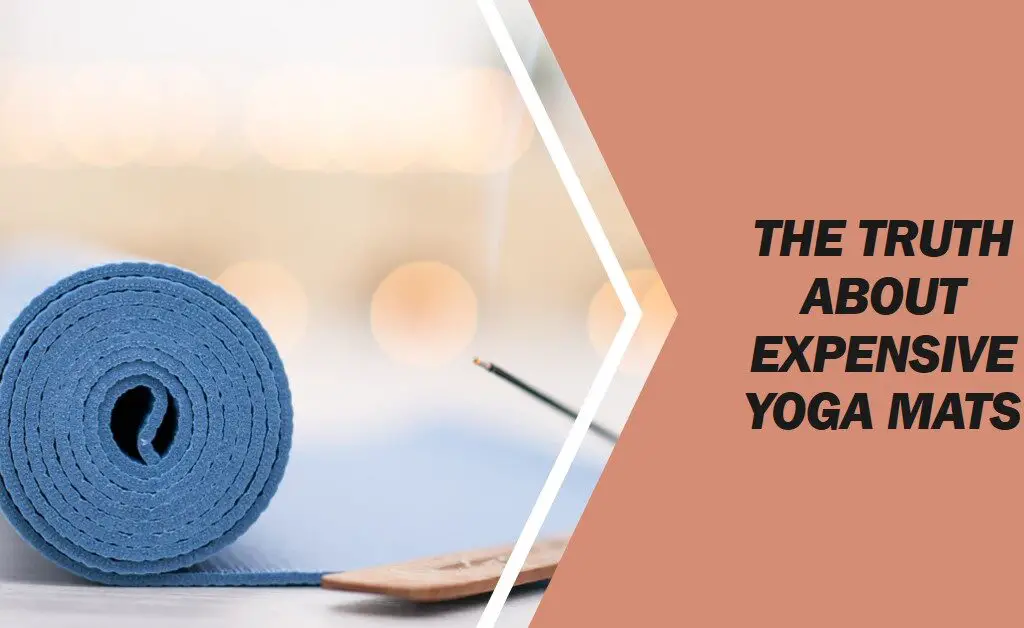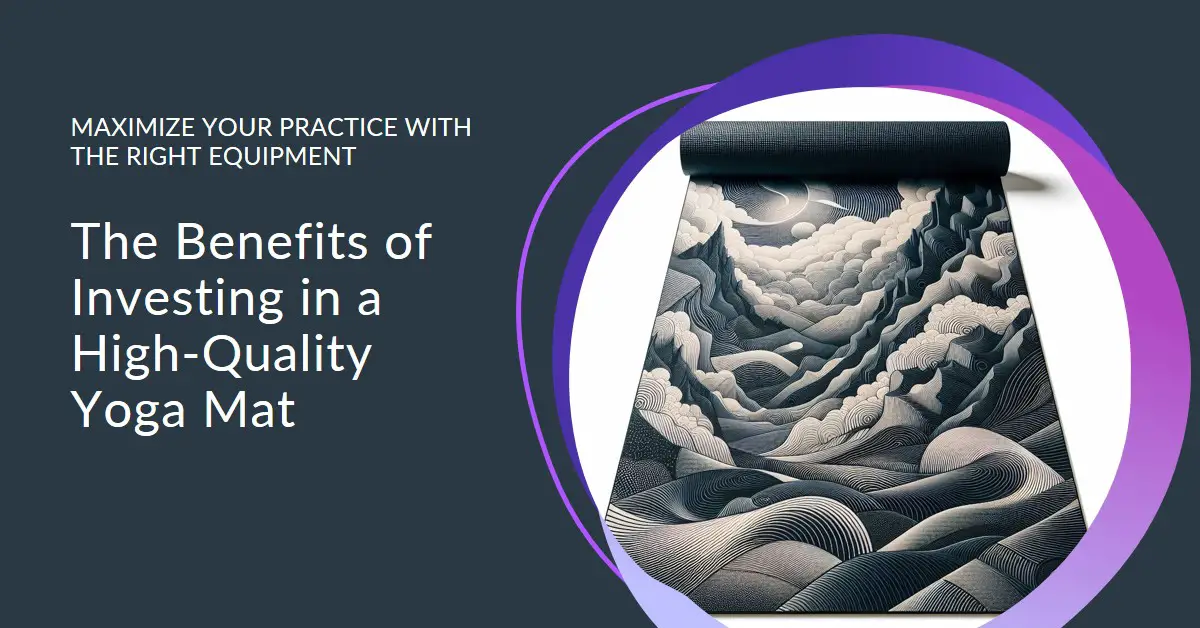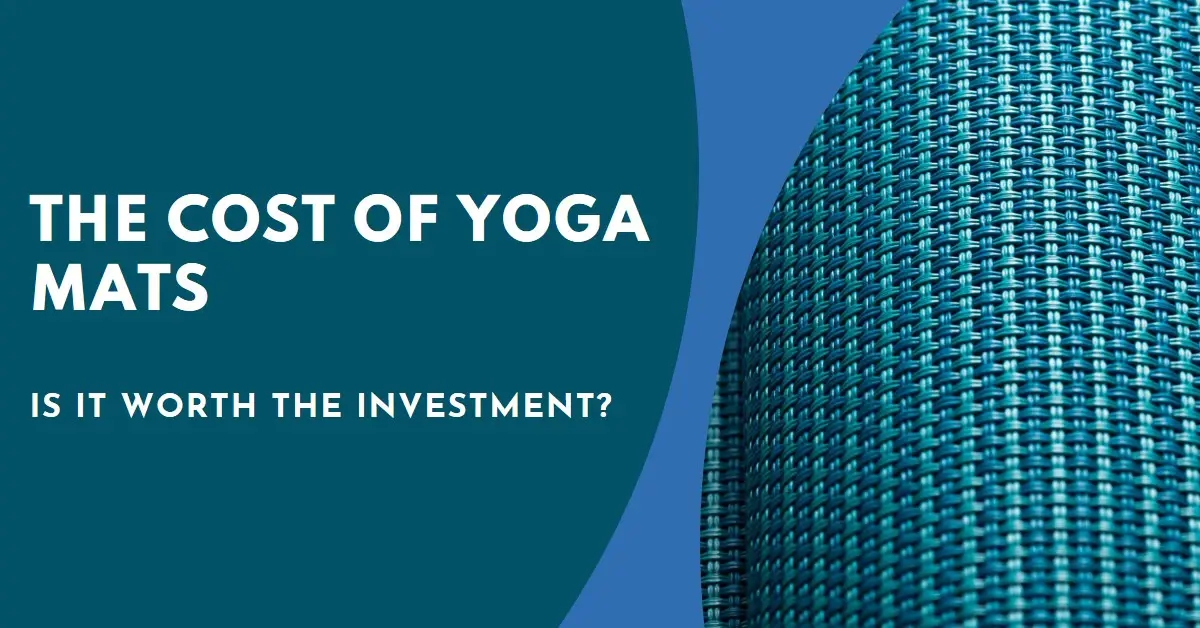Key Takeaways
- More expensive yoga mats tend to use higher quality, eco-friendly materials that make them more durable, comfortable, grippy, and worth the investment over cheaper mats.
- Factors like thickness, cushioning, stickiness, size, antimicrobial properties, and alignment cues contribute to the performance of a yoga mat.
- Investing in an expensive yoga mat from a reputable brand can save money in the long run since they last longer without needing frequent replacement.
- Expensive yoga mats provide stability, prevent slipping and injuries, align the body properly, and allow yogis to go deeper into poses with confidence and comfort.

Does an Expensive Yoga Mat Make a Difference?
Greetings, friends! I’m Ashokkumar, founder of Medi Temple. As an experienced yoga teacher and lifelong student, I’m often asked if spending more on a high-quality yoga mat is truly worth it.
In my personal practice and years of guiding students, I’ve tested countless mats from cheap basic ones to premium brands costing over $100. Through trial and error, I’ve learned that yes, an expensive yoga mat makes a tremendous difference compared to a budget pick.
As we explore this topic in-depth, you’ll discover what sets expensive yoga mats apart, whether the investment justifies the costs, and how to choose the best mat for your individual needs and budget.

Why Invest in an Expensive Yoga Mat?
Here are the main reasons why expensive yoga mats from reputable brands are worth the higher costs:
1. More Durable and Long-Lasting
Cheap basic yoga mats tend to deteriorate quickly with regular use. Their thin PVC foam construction tears easily, needs frequent replacement, and ends up costing more over time.
Expensive yoga mats use dense, high-quality materials like natural tree rubber, polyurethane blends, or sustainably harvested cork. This makes them incredibly durable to withstand daily practice for years without wearing out.
As you’ll use a yoga mat almost daily, investing in one that lasts is prudent. With proper care, a $100+ yoga mat can serve you reliably for a decade, making it a sound investment.
2. Better Cushioning and Joint Protection
Thin, cheap mats provide very little padding, leading to wrist, knee and joint pain during yoga flows and holding poses.
Conversely, expensive mats use advanced technological construction and materials to provide exceptional cushioning. This minimizes impact and strain on the joints, allowing you to practice comfortably.
For seniors, people with injuries, and those with tender joints, a well-cushioned expensive yoga mat is a worthwhile investment for pain-free sessions. Even younger yogis benefit from the protective padding during intense power flows.
3. Superior Grip and Stability
Inadequate grip is a common issue with cheap basic mats, causing unstable sliding and slipping during sweaty hot yoga sessions. This can lead to poor alignment or injury from falling out of balancing poses.
Expensive yoga mats utilize intelligent textured surfaces, moisture-wicking fabrics, or sustainably harvested natural tree rubber. This gives an incredibly secure grip, even when wet with sweat, providing the stability needed to hold poses with perfect form.
The exceptional traction also builds core and muscle strength as you rely less on the mat’s stickiness to hold challenging poses.
4. More Eco-Friendly Materials
Cheap yoga mats are typically made from non-biodegradable PVC, a major environmental pollutant emitted from landfills and factories.
Conversely, reputable high-end yoga mat companies like Manduka use natural, sustainably harvested tree rubber or organic materials like cork and cotton. These renewable resources make expensive yoga mats easier on the planet.
As yogic principles encourage environmental harmony, eco-conscious yogis appreciate expensive yoga mats’ sustainable sourcing and manufacturing.
5. Tailored Sizing and Alignment Cues
Expensive yoga mats offer more size options to suit yogis of all shapes and heights. Standard sizes can be too narrow or short for larger practitioners, limiting mobility and alignment. Premium mats provide wider and longer dimensions for unrestricted flows.
Some high-end mats also have printed alignment cues showing ideal hand and foot positions. These visual guides help to correctly place your body, improving form and building muscle memory faster.
6. Antimicrobial Properties
Cheap mats easily absorb sweat, skin oils, and dirt into the open-cell porous PVC foam. This allows odor and bacteria buildup over time unless vigorously sanitized.
By contrast, expensive yoga mats feature antimicrobial copper ions or a closed-cell non-porous surface that repels moisture absorption. This deters bacterial and fungal growth for better hygiene and fewer unwanted odors.
Factors that Contribute to an Expensive Yoga Mat’s Performance
From materials to thickness and size, several vital factors determine a yoga mat’s quality, functionality and price point. Let’s examine them in detail:
Materials
- PVC Foam – Cheap, non-eco-friendly basic mats use non-recyclable PVC foam. Avoid these mats as they wear out quickly.
- Natural Tree Rubber – Premium natural tree rubber mats like those from Jade Yoga provide excellent grip, cushioning, and durability.
- Polyurethane – Lightweight polyurethane mats are extremely durable and maintain good grip when wet with sweat. Manduka eKO Superlite mats use quality polyurethane.
- Cork – Sustainably-harvested cork mats like those from YOLOH studio are lightweight, antimicrobial, and provide good grip and joint support.
- Cotton – Natural cotton mats are excellent for building core strength as they have less stickiness that demands more muscle engagement.
Thickness
- Ultra-thin (1/16 inch) mats are best for travel but lack adequate cushioning.
- Standard home practice mats range from 1/8 to 1/4 inch thickness. This is ideal for most users.
- Extra thick (1/4+ inch) mats provide ample cushioning but are heavy and can hinder balance.
Texture
- Smooth, flat surfaces allow fluid transitions between poses.
- Textured, etched surfaces provide exceptional dry grip and stability.
Weight
- Lightweight mats under 5 lbs are preferable for portability and travel.
- Heavier mats over 5 lbs provide more padding and floor traction at home.
Size
- Standard sizes are 24 inches wide and 68-72 inches long.
- Extra wide and long mats suit taller or larger builds better.
Eco-Friendliness
- Materials like PVC foam and EVA are tougher on the environment.
- Natural rubber, cotton, cork and jute are more sustainable materials.
Price Range
| Type | Price Range |
|---|---|
| Basic | Under $50 |
| Mid-Range | $50 – $100 |
| Premium | Over $100 |

Are Expensive Yoga Mats Worth the Cost?
While basic mats under $50 serve fine for beginners practicing occasionally, intermediate to advanced yogis practicing several times weekly reap extensive benefits from a premium mat costing over $100.
You derive much more value from an expensive yoga mat through factors like longevity, grip, alignment, eco-sustainability and joint protection. These directly contribute to taking your practice to deeper levels with better form and injury prevention.
Let’s compare expensive yoga mats to budget options based on key criteria:
| Criteria | Cheap <$50 | Expensive $100+ |
|---|---|---|
| Durability | Break down within months | Last for years |
| Grip | Slippery, unstable | Excellent dry/wet grip |
| Joint Support | Minimal padding | Ultra-cushioned |
| Eco-Friendly | PVC foam, not recyclable | Natural materials, sustainable production |
| Hygiene | Absorbs sweat and bacteria | Antimicrobial, closed-cell surface |
| Injury Risk | High from slipping | Extremely low |
| Muscle Engagement | Over-reliance on mat stickiness | Builds more core and muscle strength |
| Value For Money | Replace often, costs more over time | One-time investment lasting years |
As evident from the table, any type of expensive yoga mat often outperforms budgeted ones across all parameters. For serious yogis practicing frequently, a high-quality expensive yoga mat is well worth the investment.
How To Choose The Best Yoga Mat
Keep these key tips in mind when selecting an expensive high-performance yoga mat:
1. Identify The Right Thickness
- Ultra-thin 1/16 inch mats for travel
- Standard thickness of 1/8 to 1/4 inch for home use
- Extra thick 1/4+ inch mats provide ample padding for therapeutic needs
2. Consider The Materials
- Natural tree rubber, polyurethane or cork provide grip, cushioning and sustainability.
- Avoid basic mats made from PVC foam.
3. Check Length And Width Dimensions
- Standard size is 24″ x 68″ length.
- Choose extra wide and long mats if over 6 feet tall.
4. Evaluate Texture And Grip
- Smooth surfaces allow fluid transitions between poses.
- Textured surfaces provide exceptional traction when wet.
5. Assess Weight
- Lightweight for travel under 5 lbs
- Heavier materials over 5 lbs enhance home traction
6. Read Reviews And Ask Instructors
- Verify claims of durability, performance and quality from customer reviews and yoga teachers.
7. Compare Brand Reputations
- Reputable brands like Manduka and Jade Yoga are known for exceptional quality and durability.
8. Check For An Extended Warranty
- Many premium mats come with 6-10 years coverage against manufacturing defects.
9. Buy From Official Brand Stores Not Resellers
- Listings on Amazon/Ebay may be counterfeit products with substandard quality.
10. Consider Bundle Deals
- Buying a mat with accessories like yoga blocks and straps saves money.
Recommended Expensive High Quality Yoga Mats
Based on testing numerous mats personally and with students, I highly recommend these exceptional expensive yoga mats worth investing in:
- Ultra-dense PVC cushioning
- Unmatched joint protection
- Textured dot pattern bottom prevents sliding
- Standard and extra long size options
- 10-year warranty
- Sustainably sourced natural tree rubber
- Excellent grip even when wet
- Lightweight and easily portable
- Standard and extra long variants
- Lifetime warranty
- Sustainably harvested cork material
- Exceptional traction and cushioning
- Antimicrobial and moisture-wicking surface
- Standard and large size options
- 5-year warranty
Manduka Eko Superlite Yoga Mat
- Premium lightweight polyurethane material
- Easy to clean closed-cell surface
- Excellent dry and wet grip
- Standard size perfect for travel
- Lifetime warranty
- Innovative ultra-grippy material
- Printed alignment markers for precision
- Sweat-resistant and antimicrobial
- Standard size with good portability
- 4-year warranty
The Takeaway
At the end of the day, the value you derive from a yoga mat depends hugely on the quality of materials, construction techniques and innovative features used. These directly impact the traction, stability and longevity you experience in practice.
While basic mats serve fine casually, intermediate to advanced yogis practicing several times weekly gain tremendous benefits from investing in an expensive premium yoga mat.
Factors like durability, grip, cushioning and antimicrobial properties in high-end mats from reputable brands justify costs ranging from $100-$150. These can serve reliably as your trusted yoga companion for years to come.
I hope this detailed exploration clarifies why expensive yoga mats are worth the investment over cheap
FAQs
What is the best type of yoga to start with as a beginner?
For beginners, Hatha and Vinyasa flow yoga are good types of yoga to start with. They help build strength, flexibility and balance at a comfortable pace.
How often should you practice yoga to see benefits?
To see the full benefits of yoga, aim to practice at least 3 times per week. Even 20-30 minutes per yoga practice can be very beneficial for the mind and body.
What thickness of yoga mat is best?
The standard thickness for home yoga practice is 1/8 inch to 1/4 inch. This provides adequate cushioning and stability during most poses. If you have sensitive joints, a thicker 1/4 inch+ mat provides ample support.
Can I practice yoga on a hard floor without a mat?
It is not advisable to practice yoga on hard floors without a mat as this can strain the wrists, knees and spine. Always use a yoga mat or folded blanket to cushion the body.
What material are Manduka yoga mats made from?
Manduka makes exceptional yoga mats from dense, high-quality PVC foam that provides unmatched cushioning and joint protection during yoga practice.
Can you use a yoga mat on carpet?
Yes, you can use yoga mats on plush carpets, but they tend to move around, losing stability. For carpets, use a non-slip mat or place a towel between the mat and carpet to prevent sliding.
How do I know which side of my mat is the grippy side?
Most yoga mat textures are the same on both sides. But if one side features a smooth flat surface and the other side has a textured grippy pattern, use the textured side facing downwards for the floor.
Why does my yoga mat smell bad sometimes?
Yoga mats absorb sweat and bacteria which causes unpleasant odors over time. Use an antibacterial yoga mat spray and wipe it down after every practice to eliminate odors.
Can I machine wash my yoga mat?
No, don’t machine wash yoga mats as this can damage their shape and materials. Use a mild soap solution instead and air dry the mat before rolling up.
How do I stop my hands and feet from sliding on the yoga mat?
If your yoga mat is slippery, try dampening your palms and soles slightly before practice. This helps improve grip and traction. Also ensure the textured grippy side of the mat faces downwards.
What yoga poses are best for beginners?
Beginner-friendly yoga poses include Child’s Pose, Downward Dog, Tree Pose, Mountain Pose, Standing Forward Fold and Corpse Pose among others. These build strength gently while enhancing flexibility.
Can I practice hot yoga without a mat?
It is risky practicing hot yoga without a yoga mat even on wooden floors as sweat causes the body to slide, leading to potential injury. Always use a sweat-resistant yoga mat.
Which side of the yoga mat should face up?
The smoother flat side of the yoga mat generally goes face up to allow smooth transitions between poses. The textured bottom side sticks to the floor providing traction.
What size yoga mat do I need?
The standard yoga mat size is 24 inches wide and 68 inches long. If over 6 feet tall or a larger build, choose an extra thick (1/4 inch+) and extra wide/long mat for comfort.
What is the Manduka yoga mat made of?
The legendary Manduka Pro mat is made from ultra-dense cushioning PVC foam that provides unmatched joint protection during yoga practice. Its proprietary dot patterned bottom provides a no-slip grip on any surface.
How thick are Manduka yoga mats?
Manduka offers mats in different thickness options. The standard Manduka Pro is 6mm thick (1/4 inch). The Manduka PROlite is 4mm thick (1/8 inch). And the ultra-portable Manduka Eko Superlite is 1.5mm (1/16 inch).
Can I practice yoga without going to a studio?
Absolutely! While yoga studios provide guidance and community, an expensive yoga mat may give you the ability to practice comfortably at home. Clear space, use a non-slip mat, and follow online/DVD classes.
How often should you clean your yoga mat?
Ideally clean your yoga mat after every practice. Use an antibacterial yoga mat spray to kill germs, then wipe with a damp cloth. Deep clean weekly by scrubbing both sides with gentle soap and water.
What thickness of yoga mat is best for hot yoga?
It’s important to ensure the yoga mat thickness. For hot yoga which involves profuse sweating, use a thicker 1/4 inch mat at minimum to provide ample moisture absorption, traction and knee support in poses. The excellent grip of Manduka mats makes them ideal for hot yoga.
